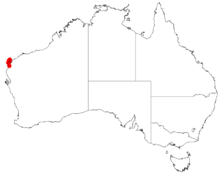| Acacia alexandri | |
|---|---|
| Conservation status | |
 Priority Three — Poorly Known Taxa (DEC) | |
| Scientific classification | |
| Kingdom: | Plantae |
| Clade: | Tracheophytes |
| Clade: | Angiosperms |
| Clade: | Eudicots |
| Clade: | Rosids |
| Order: | Fabales |
| Family: | Fabaceae |
| Subfamily: | Caesalpinioideae |
| Clade: | Mimosoid clade |
| Genus: | Acacia |
| Species: | A. alexandri |
| Binomial name | |
| Acacia alexandri Maslin | |

| |
| Occurrence data from AVH | |
| Synonyms | |
| |
Acacia alexandri is a species of flowering plant in the family Fabaceae and is endemic to the Cape Range in the north-west of Western Australia. It is a glabrous shrub with slender branchlets, linear phyllodes, and cream-coloured flowers arranged in 1 or 2 spherical heads in the axils of phyllodes, and narrowly oblong, papery pods up to 70 mm (2.8 in) long.
Description
Acacia alexandri is a glabrous, open or moderately dense shrub that typically grows to a height of 1.5–3 m (4 ft 11 in – 9 ft 10 in) and has slender branchlets. Its phyllodes are linear, narrowed at the base, 60–130 mm (2.4–5.1 in) long and 2.5–6 mm (0.098–0.236 in) wide, 9–11 mm (0.35–0.43 in) wide on some specimens. There are spiny stipules 3–4 mm (0.12–0.16 in) long at the base of phyllodes, but sometimes absent from mature phyllodes. There is a sometimes obscure gland up to 2 mm (0.079 in) above the pulvinus.
The flowers are arranged 1 or 2 spherical heads in the axils of phyllodes, on a peduncle 8–15 mm (0.31–0.59 in) long with 60 to 80 cream-coloured flowers. Flowering mostly occurs from August to September, and the pod is papery, narrowly oblong, and prominently rounded over the seeds, up to 70 mm (2.8 in) long and 7–8 mm (0.28–0.31 in) wide. The seeds are dull blackish, spherical and about 4 mm (0.16 in) long.
Taxonomy
Acacia alexandri was first formally described in 1992 by Bruce Maslin in the journal Nuytsia from specimens he collected in the Cape Range in 1988. The specific epithet (alexandri) honours Alex George, who discovered the species in 1960.
Distribution and habitat
This species of wattle is endemic to the Cape Range in the Gascoyne region of Western Australia around Cape Range where it is found on rocky limestone hillsides as part of mallee shrubland communities growing in rocky, pink loamy soils.
Conservation status
Acacia alexandri is listed as Priority Three by the Government of Western Australia Department of Parks and Wildlife, meaning that it is poorly known and known from only a few locations but is not under imminent threat.
See also
References
- ^ "Acacia alexandri". Australian Plant Census. Retrieved 2 June 2024.
- ^ "Acacia alexandri Kodela & Tindale (ms)". World Wide Wattle. Western Australian Herbarium. Retrieved 2 June 2024.
- ^ Kodela, Phillip G. Kodela, Phillip G. (ed.). "Acacia alexandri". Flora of Australia. Australian Biological Resources Study, Department of Climate Change, Energy, the Environment and Water: Canberra. Retrieved 2 June 2024.
- ^ Maslin, Bruce R. (1992). "Acacia Miscellany 6. Review of Acacia victoriae and related species (Leguminosae: Mimosoideae: Section Phyllodineae)". Nuytsia. 8 (2): 288–290. Retrieved 2 June 2024.
- "Acacia alexandri". Australian Plant Name Index. Retrieved 2 June 2024.
- ^ "Acacia alexandri". FloraBase. Western Australian Government Department of Biodiversity, Conservation and Attractions.
- "Conservation codes for Western Australian Flora and Fauna" (PDF). Government of Western Australia Department of Parks and Wildlife. Retrieved 8 May 2024.